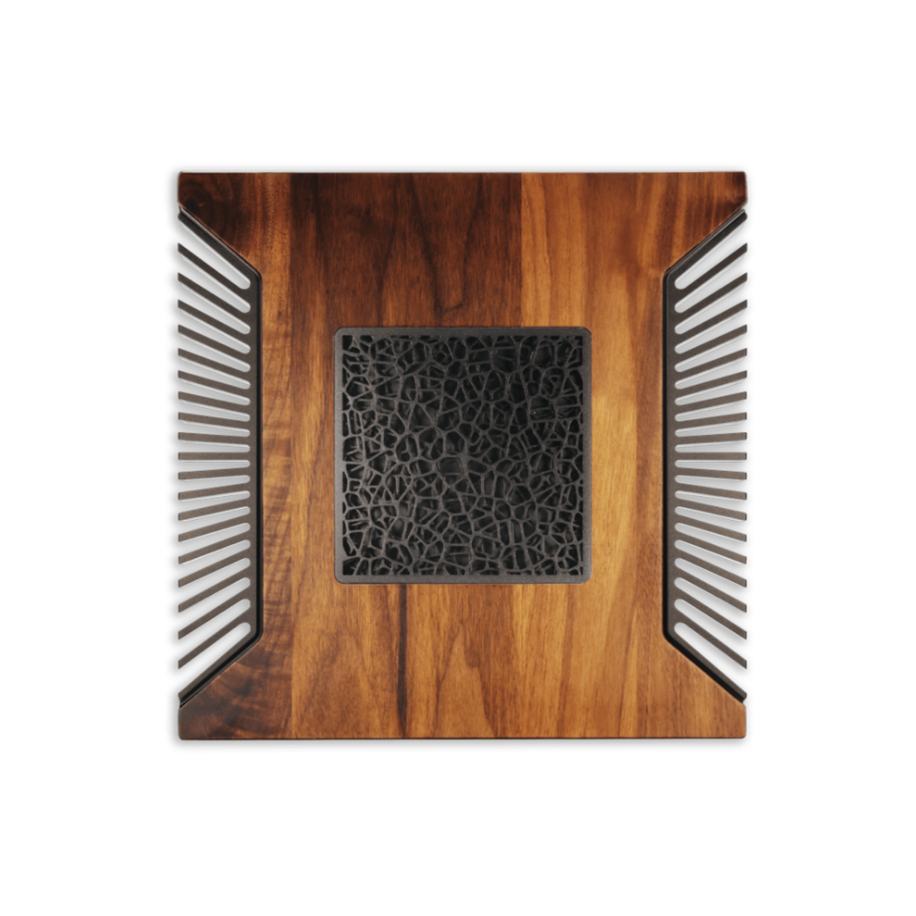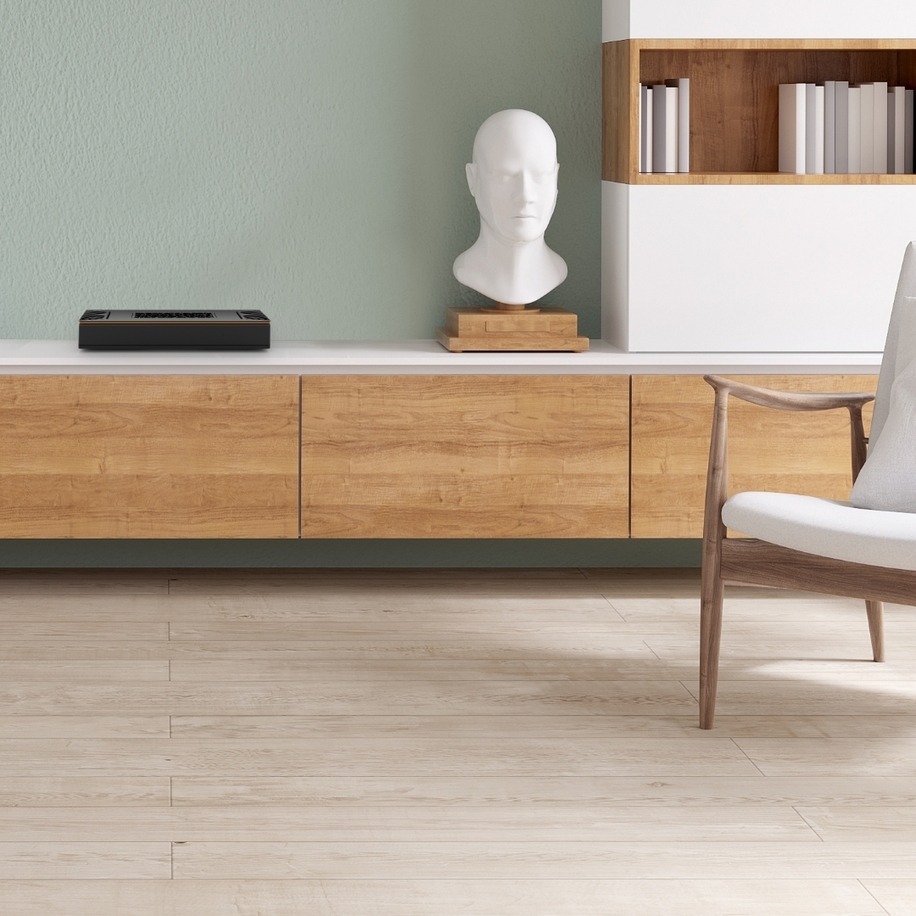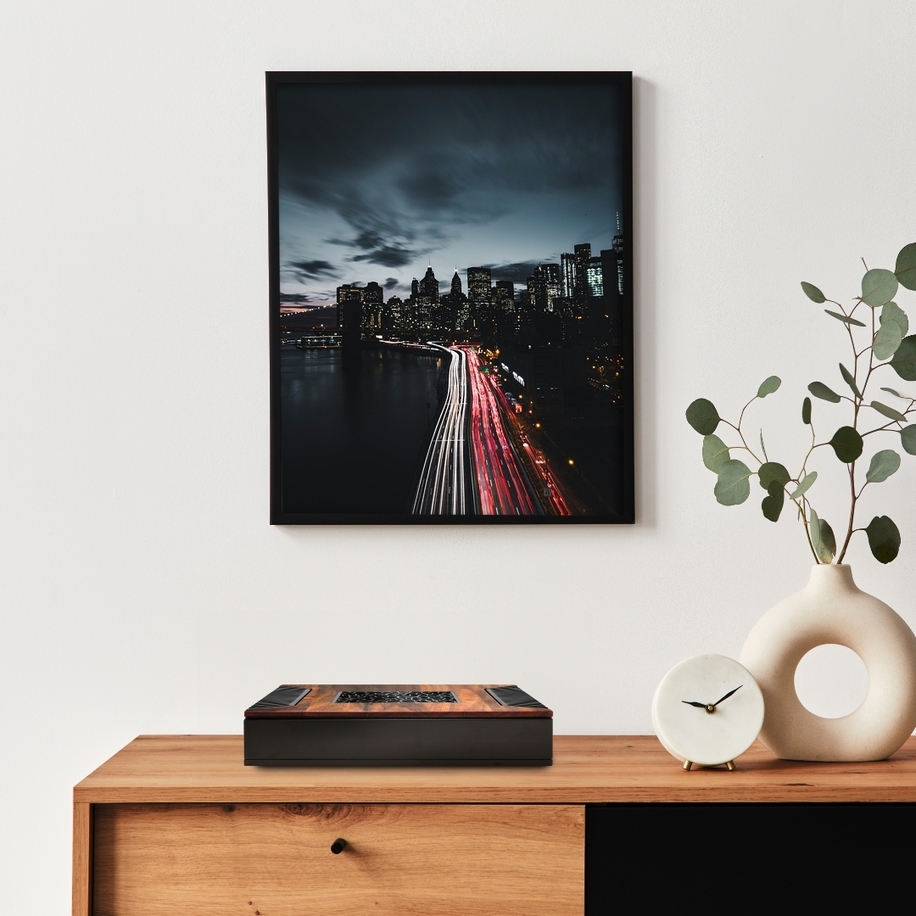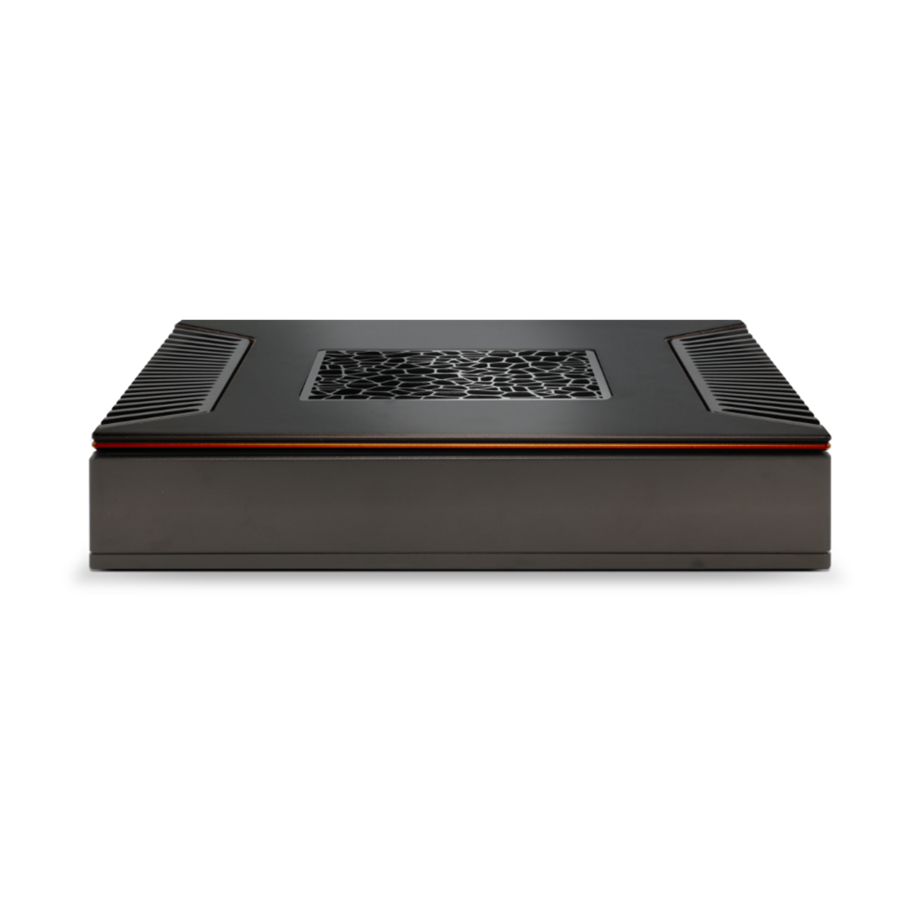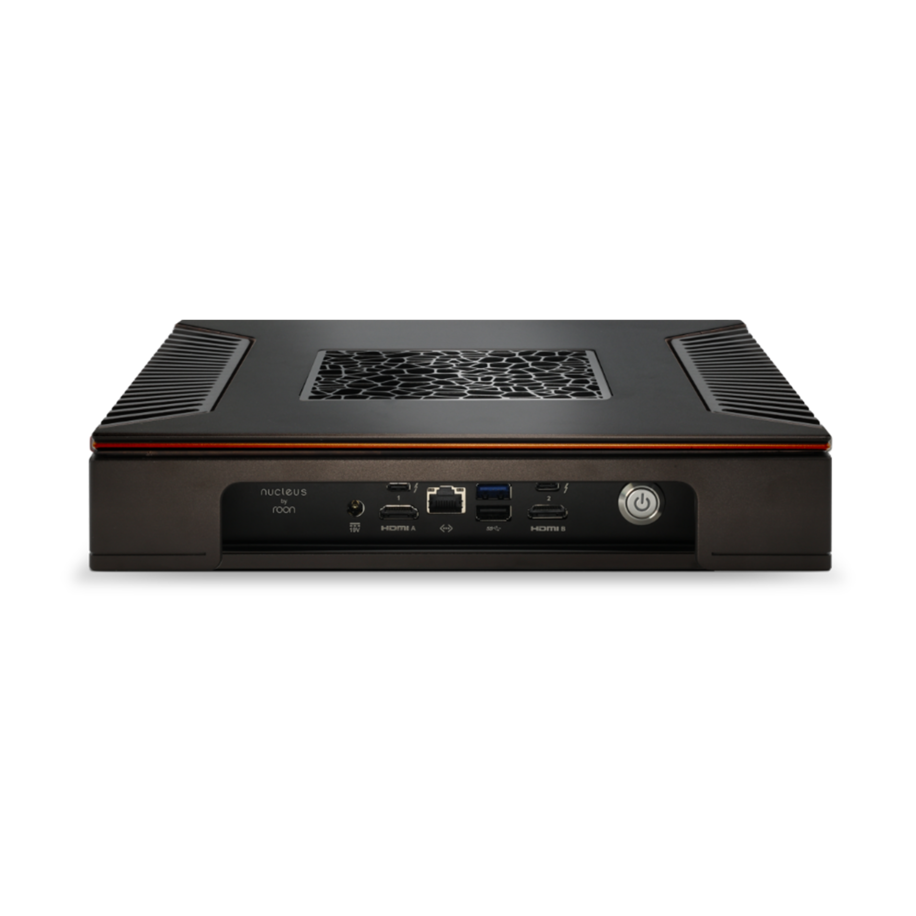Herculean integration power, colossus processing and god-like beauty – can Roon’s new Nucleus Titan flagship deliver divine inspiration to mortal AV installers?
You have got to love the new Roon Nucleus Titan straight out of the box. It promises all of the goodness of the original Roon Nucleus with some additional specs and a chassis that would look the part as the centrepiece of a top-flight Hi-Fi system rack in the living room. It’s a solid, billet-machined aluminium case with gorgeously crafted side-cooling fins and a hefty top-plate available in three colour options – wood, stone marble or dark grey with funky bronze edge detail.
The top plate is inlaid with multi-layer filigree metalwork that covers the large square case port, aiding passive cooling as there is no fan. As vent grilles go, this is the Gucci of grilles. There is no doubt in my mind that audio giant Harman, which recently acquired Roon, had a significant hand in the investment and creative execution of this industrial design. This level of eye candy may be a little moot for rack-mount installations, but I’d always opt for style over otherwise fantastic products that look like they were designed by a 10-year-old and haven’t changed their appearance for years. (I am looking at you, Meridian 218.)
So, other than wowing with its build quality and sheer style, how far does the Titan go in justifying its near doubling in retail price over the outgoing Nucleus Plus model or even the multiples over the very affordable Nucleus One?

Top of the line
Positioned as the new Roon flagship, the Nucleus Titan brings new levels of processing power and integration capability, improved connectivity and is easier to set up and use. It also claims to offer better audio performance, thanks mainly to its fanless and all-solid-state design. It comes with the full suite of MUSE Precision Audio Control DSP functions for the like of RoomEQ, upsampling and headphone-centric sonic features.
At its core, the Titan is a Roon OS appliance. It runs the same powerful software as the original Nucleus but is equipped with considerably more computing headroom thanks to Intel’s latest-generation NUC compute module. Library capacity has no stated upper limit, but Roon claims ‘over 100,000 tracks’ for the Titan compared to the One’s ‘up to 100,000’. Storage options are also improved. The Titan supports both internal SSDs and external USB storage, offering faster transfer rates and improved heat management compared to the Nucleus. For customers with extensive local libraries, particularly those ripping large CD or SACD collections to FLAC or DSD, this could be a key selling point.
For installers, perhaps the most critical advances lie in the Titan’s enhanced integration options. The Titan supports Roon’s latest API architecture, ensuring smoother compatibility with Crestron, Control4, ELAN, RTI and several other control platforms. With Control4 for example, certified drivers ensure that Roon zones appear as native media zones, with track metadata and zone control accessible directly within the Control4 interface.
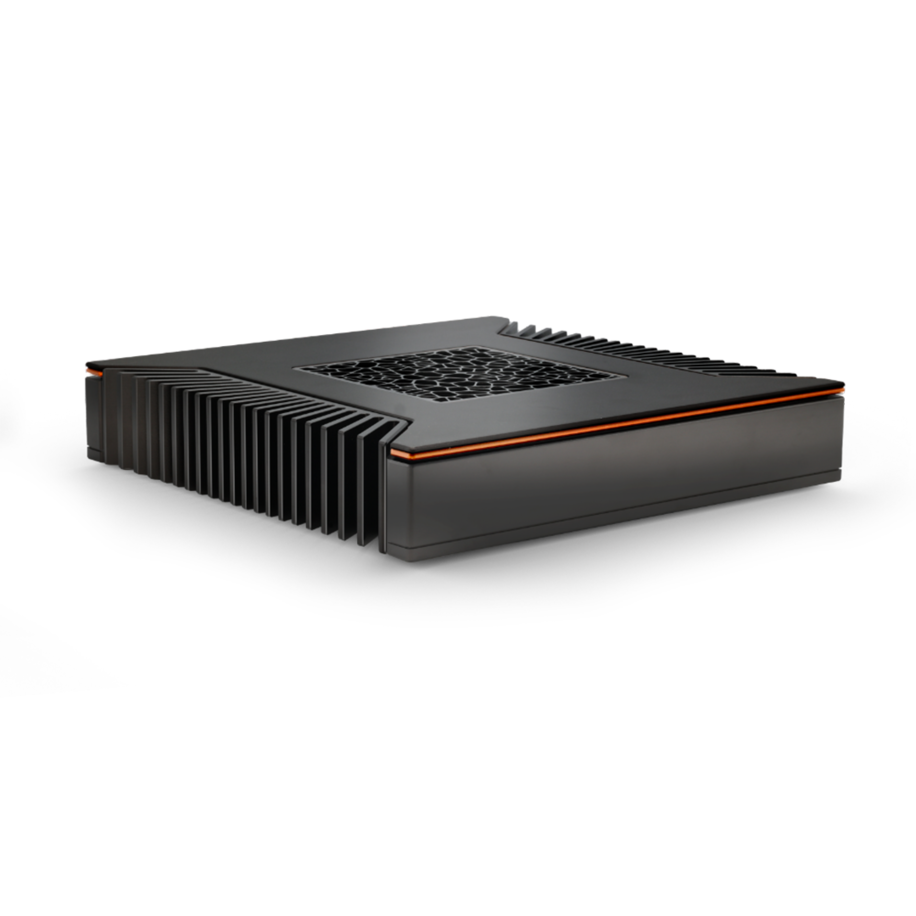
Crestron users benefit from similar native zone integration, including support for touchscreen metadata, browsing and transport control. For multi-room installations spanning multiple brands and interfaces, this kind of plug-and-play interoperability should streamline commissioning and reduce ongoing support needs. That is arguably the most important feature for professional installers, where system reliability and service contract efficiency are key metrics of profitability.
For the end user, this kind of tight integration reduces the need for parallel apps or workarounds and offers a more unified audio library experience, which is essentially the whole premise of Roon in the first place. The Titan still unifies local libraries with the likes of Tidal, Qobuz, Spotify Connect via third-party endpoints, into one rich interface. It is metadata-driven and album-centric, designed to appeal to serious music fans who want to cut to the heart of the music and artist rather than faff around with multiple apps and Googling details.
For installers required to integrate Roon as a front-end to an existing static or distributed audio system, whether via Roon Ready endpoints from brands like Linn, dCS, KEF, or Bluesound, or using a Roon Bridge into legacy DACs, the Titan makes system connectivity even easier. These include USB 3.0 (2x USB-C and 2 x USB-A), HDMI and dual Ethernet ports, allowing for redundancy or network isolation for audio zones. Internal solid state storage options include 0, 3, 4 or 8TB drives – albeit at a premium that PC-centric users may find a little spendy in comparison to off-the-shelf SSDs.

Crushing it with Cronus
While not strictly a Titan feature, the interface, whether accessed via a tablet, phone, or integrated control system, remains an intuitive yet detailed user experience, rich in information and seamlessly integrated across local and streamed sources. There really is nothing else like it, and for music-centric customers, it should be top of the offers list. Like myself and many of my erudite reviewer colleagues over in the dedicated consumer Hi-Fi media that are playing and listening to music every day, the Roon OS is pretty much a default front end in some way, shape or form.
In terms of the Titan’s sonic performance, the lack of fan, solid state drives, uprated power supply and robust engineering should all pay dividends, although Roon endpoint hardware tends to have a much greater impact on the result. I managed to get it hooked up to my Roon account in seconds, establish my local libraries and log into Tidal and several other services seamlessly. Without a hitch, it identified and played to a house full of Roon-enabled devices from Bluesound, my go-to streamer amp, the Marantz M1 and the AV10 in the cinema. All sounded great too streaming Tidal Max.
Titan has been designed to scale too, offering system expansion opportunities into the future. It can process DSD and PCM upsampling to multiple endpoints simultaneously and supports multi-zone DSP without compromising responsiveness. That could be an issue with earlier iterations of the Nucleus that would get seriously toasty and slow down under extreme load, despite blowing fans.
As clients who are more engaged with their music are more likely to invest in multi-zone audio, higher-end DACs, or upgraded speakers, the Titan is sort of a gateway drug to bigger connected audio systems throughout the home. Roon, and by extension the Titan, becomes a tool not just for playback but for deepening the client’s connection with their system and ideally the installer’s ongoing relationship with the client.
Despite being wowed by the industrial design of the Titan, I came to this review with the specs in mind and thinking there wasn’t much of an upgrade over the One to justify the higher price. Yet using and understanding the Titan in its context makes much more sense. It is essentially a statement piece that backs up its rather glorious physical presence with software intelligence, platform flexibility and a commitment to long-term support that reflects Roon’s broader ambitions in the custom integration space.
Being shallow, I would buy it for the marble-stone finish top and impressive Art Deco grille alone.



